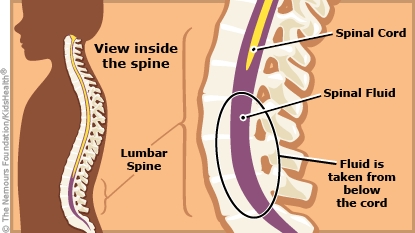After a Spinal Tap: How to Care for Your Child
It can be frightening when your child needs a lumbar puncture, but it is a common and safe test that usually is not painful.


A lumbar puncture (LP), also called a spinal tap, is a test to look at the cerebrospinal fluid (CSF) that surrounds the spinal cord and brain. This colorless fluid delivers nutrients and "cushions" the brain and spinal cord.
During an LP, a special needle is inserted into the lower spine, below the spinal cord, to collect a sample of this fluid. The fluid sample can help the health care provider diagnose various diseases. Most often an LP is done to test for meningitis, but it also can be done to test for bleeding in the brain or certain diseases of the nervous system. The lab studies the fluid for white blood cell count, glucose levels, protein, and bacteria. During an LP, the pressure in the fluid might be measured, which also can help the health care provider diagnose certain conditions.
Some kids need to have a sedative medication before the LP procedure. Your health care provider would have spoken with you if these medications were necessary for your child's comfort.
The position of the body is important during an LP. The treatment team made sure your child was in the proper position. After your child's back was cleansed, the health care provider injected a numbing medicine into the skin around the lower spine. The health care provider then inserted a spinal needle and collected the fluid sample.
After the LP, your child may have a mild headache or backache. Some tiredness is also normal. It is safe for your child to go home. Make sure you feel comfortable that all of your questions are answered by the health care provider.

-
Allow your child to rest as much as needed.
-
For pain, a medication may help your child feel better:
-
For children under 6 months, you may give acetaminophen.
-
For children over 6 months, you may give acetaminophen OR ibuprofen, if recommended by your health care provider.
-
Make sure your child drinks plenty of fluids.
-
Keep an eye on the puncture site for redness or signs of infection.

Your child:
-
Is getting more irritable (fussy)
-
Has a headache or back pain that seems to be getting worse.
-
Develops pain in the legs.
-
Is vomiting.

Your child:
-
Has redness, swelling, pain, or bleeding at the LP site.
-
Has numbness or weakness in the legs or trouble walking.
-
Appears dehydrated; signs include dizziness, drowsiness, a dry or sticky mouth, sunken eyes, producing less urine or darker than usual urine, crying with little or no tears.